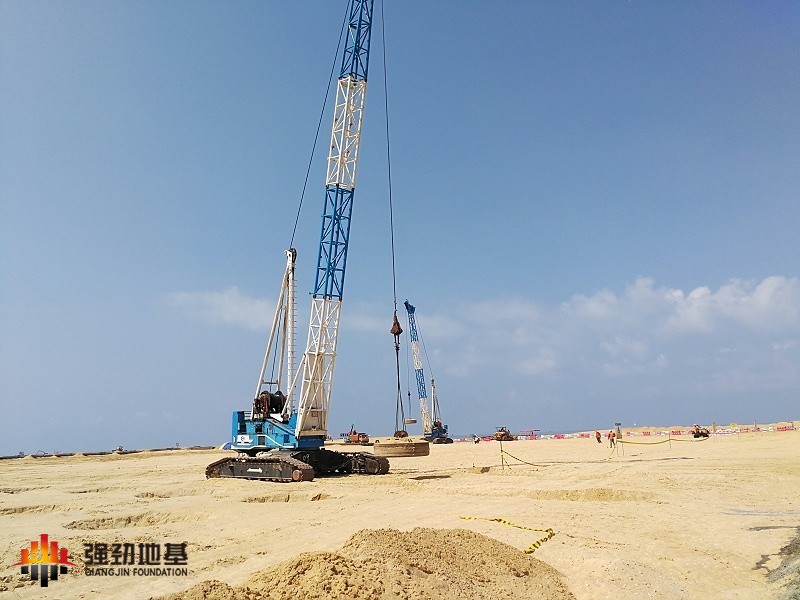When discussing the concrete problems of the basic principles of foundation treatment design, it is necessary to recognize the following working conditions for the engineering characteristics of the treated foundation and the natural foundation :(1) the range of the treated foundation should be the minimum range that meets the requirements of the bearing capacity, deformation and stability of the building foundation. For example, for compactness treatment of deep fill soil, liquefaction treatment of liquefied soil layer elimination, and foundation treatment of collapsible loess elimination and reduction of collapsible damage, the treatment range is required to be greater than the foundation bottom area of the building, and not less than 1/2 of the treatment depth.
When discussing the concrete issues of the basic principles of foundation treatment design, it is necessary to recognize the following working conditions for the engineering characteristics of the treated foundation and the natural foundation:
(1) The scope of foundation treatment should be the minimum range to meet the requirements of building foundation bearing capacity, foundation deformation and stability. For example, the compaction treatment of deep fill soil, the elimination of liquefaction treatment of liquefied soil layer, the elimination of collapsible loess to reduce the damage of collapsible foundation treatment, etc., all require that the treatment range is greater than the foundation bottom area of the building, not less than the treatment depth1/2In other words, the treated foundation under this condition meets the functional requirements of the building within a limited range. In this case, the design of building foundation should evaluate the adverse effects of the untreated site foundation on the building under adverse conditions such as earthquake load, foundation pit excavation, rainstorm and artificial slope.
(2)The foundation bearing capacity, deformation and stability of the building built on the treatment foundation are calculated, and the compactness treatment of deep fill soil, liquefaction treatment of liquefied soil layer, and foundation treatment of collapsible loess elimination and reduction of collapsible damage are required to meet the requirements in the treatment range. In this case, the foundation treatment should meet the requirements of the foundation treatment according to the principle of uniform treatment. At this time, the design parameters of the treated foundation are not directly related to the layout of the foundation.
(3) When the bearing capacity and deformation of the building foundation still do not meet the requirements after uniform treatment, reinforcement is often arranged in the foundation. At this time, the designer should have a correct understanding and judgment of the result of the interaction between the building and the foundation after treatment. As for the understanding of the interaction between the building and the foundation after treatment, the accumulated engineering data are still few, and the basic research needs to be further deepened. In general, the linear distribution of ground reaction force is still used to simplify the calculation of ground bearing capacity and deformation in practical projects.
The core problem of building foundation treatment design is to make the building built on the treated foundation meet the requirements of foundation bearing capacity, foundation deformation and stability. The so-called "building foundation" refers to the foundation under the stable condition of the building site, which is different from the yard foundation and roadbed. The bearing capacity of the main stress layer of the foundation is related to the load transfer characteristics and stiffness of the superstructure and foundation, and the deformation of the foundation is related not only to the treatment layer of the foundation, but also to the underlying layer. The calculation of stability of treated foundation should also consider the difference of calculation parameters between treated layer and its underlying layer. The treated foundation should meet the bearing capacity, deformation and stability requirements of the building foundation:
(1) When there is still a weak underlying layer within the range of the stress layer, the bearing capacity of the foundation of the weak underlying layer should be checked;
(2(for buildings or structures designed according to the deformation of the foundation or which should be checked for deformation and require foundation treatment, the deformation of the treated foundation shall be checked;
(3) For buildings and structures constructed on treated foundations subject to large horizontal loads or located on slopes, foundation stability calculations should be carried out.
The filling thickness is determined according to the bearing capacity of the underlying soil layer, so there is no longer the problem of checking the bearing capacity of the weak underlying foundation. Compaction, ramming, grouting reinforcement foundation and granular material reinforcement composite foundation should be according to the pressure diffusion Angle, according to the current national standard "Code for Design of Building Foundation Foundation"GB 50007 The method is used to check the bearing capacity of the foundation with weak underlying layer. According to the load transfer characteristics of the reinforced composite foundation with bond strength, the solid deep foundation method is used to check the calculation.
The calculation of treated foundation deformation should be in accordance with the Code for Design of Building Foundation FoundationGB 50007 The stability can be calculated according to the Technical Code for Building Foundation Treatment.JGJ 79 Of the relevant provisions.

Shanghai Qiangqiang Foundation Engineering Co., LTD. 's business covers foundation pit engineering, pile foundation engineering, land and waterFoundation treatment, slope treatment and other engineering fields. Around" Excellent technology, reliable process", construction fast "technical requirements,Is to provide customers with land, water foundation engineering technical consultation, construction services and other comprehensive solutions of the entity enterprise.Contact Number: 400-100-2850




